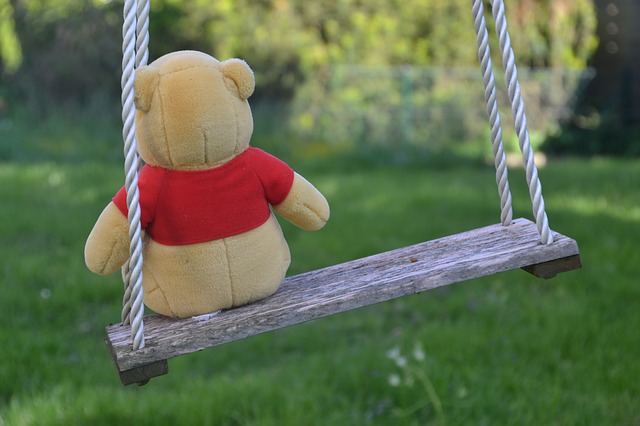
Just over a year ago, I had the opportunity to go back to London, where I always make sure to visit the Victoria and Albert Museum. I actually went back a second time in the same week because they were having a limited-time exhibit, Winnie-the-Pooh: Exploring a Classic exhibition. The walls were full of sketches and artwork and I quickly learned that A.A. Milne, while the mastermind behind the clan of characters in the Hundred Acre Wood, was only part of the magic. The beloved artist, E.H. Shepard, worked for years in partnership with Milne, bringing the Silly Old Bear and his friends’ adventures to life in four books.
The tales of Winnie-the-Pooh were based on the beloved stuffed bear of Milne’s son Christopher, immortalized in the character of Christopher Robin (the actual stuffed teddy bear is on display at the New York Public Library). However, the model of Pooh was actually based on Shepard’s son’s stuffed bear, Growler (who sadly was destroyed generations later by a neighborhood dog). Ernest Howard Shepard was a talented and well-exhibited artist when a coworker from Punch recommended him to Alan Alexander Milne as an illustrator.
Beloved by both children and adults, the tales stand the test of time partly due to their relatability, candor, and levity. Pooh, a Bear of Very Little Brain, personified attributes that showcased his sense of resilience by floating through life tied to a balloon. Can you believe that it was almost 100 years ago when he first appeared in the London Evening News in “The Wrong Sort Of Bees,” on Christmas Eve in 1925? He was wise beyond his bear years in teaching us all about:
- FRIENDSHIP and the need to lean on one another: “A friend is one of the nicest things you can have and one of the best things you can be.”
- EMPATHY and learning how to relate to others: “Weeds are flowers, too, once you get to know them.”
- GRATITUDE and recognizing what is valued: “Piglet noticed that even though he had a very small heart, it could hold a rather large amount of gratitude.”
- OPTIMISM and the exercise of looking forward: “‘It’s snowing still,’ said Eeyore gloomily. ‘So it is.’ ‘And freezing.’ ‘Is it?’ ‘Yes,’ said Eeyore. ‘However,’ he said, brightening up a little, ‘we haven’t had an earthquake lately.”’
- REFLECTION and taking stock: “How lucky I am to have something that makes saying goodbye so hard.”
- MINDFULNESS and focusing on the small moments: “‘What day is it ?’ asked Pooh. ‘It’s today,’ squeaked Piglet. ‘My favorite day,’ said Pooh.”
- SELF-AWARENESS and the need to believe in yourself and know you are not alone: “Promise me you’ll always remember: You’re braver than you believe and stronger and smarter than you think. But the most important thing is: even if we’re apart, I will always be with you in the heart.”
- PATIENCE and taking your time: “Rivers know this: there is no hurry. We shall get there someday.”
- SELF-CARE and self-respect: Piglet: “The things that make me different are the things that make me, me.”
- COMPASSION and the ability to feel: Piglet: “How do you spell ‘love’?” Pooh: “You don’t spell it … you feel it.”
So how Pooh are you? Take a “Poohsonality Test” in honor of A.A. Milne’s birthday and all of Pooh’s life lessons, then explore the wonderful world of Pooh on Pinterest and Teachers Pay Teachers, as activities and creative ideas are as full as a jar of honey.
Here are five simple ways to weave the wisdom of that Silly Old Bear into your classroom:
- Have students research A.A. Milne or E.H. Shepard by reading biographical articles or books in order to create multimedia presentations about their lives.
- Create artistic renditions of the Hundred Acre Wood and compare them to photos of Ashdown Forest in East Sussex.
- Put together a character study of each of the characters: Pooh, Piglet, Tigger, Owl, Rabbit, Eeyore, Kanga, Roo, and Christopher Robin.
- Invite in a guest reader to share a Winne-the-Pooh story.
- “Pause for Pooh” to read and discuss the significance of one of the above (or a favorite) Winnie-the-Pooh quotes.
